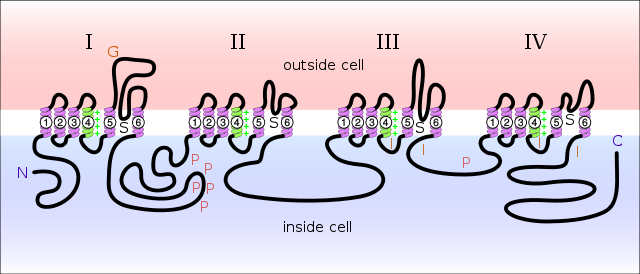Sandbox Reserved 695
From Proteopedia
(Difference between revisions)
| Line 5: | Line 5: | ||
=Epileptic drugs at Voltage-Gated Sodium Ion Channel= | =Epileptic drugs at Voltage-Gated Sodium Ion Channel= | ||
==Introduction== | ==Introduction== | ||
| - | <Structure load='2kav' size='500' frame='true' align='right' caption='Structure of one subunit of the VGSC, from pdb model "2kav"' scene='vgsc_original/1' /> | + | <Structure load='2kav' size='500' frame='true' align='right' caption='Structure of one subunit of the VGSC, from pdb model <nowiki>"2kav"</nowiki>' scene='vgsc_original/1' /> |
Under normal circumstances, the voltage gated sodium channel, or (<scene name='Sandbox_Reserved_695/Vgsc_original/1'>VGSC</scene>), serve to propagate the action potential down the axon, responding to elevated intracellular potential by opening the channel, allowing the rapid influx of sodium ions, which elevates the potential further, propagating the action potential. In a seizure, the synchronized activity of action potentials leads to very high frequency action potentials, leading to muscular convulsions and other symptoms <ref>McCormick DA, Contreras D. On the cellular and network bases of epileptic seizures. Annu Rev Physiol. 2001;63:815-46.</ref>. However, anticonvulsant drugs suppress seizures by limiting the high frequency firing of action potentials. These drugs do not interfere heavily with normal neurological activity, because they have little effect in neurons with normal resting potentials <ref>Rogawski, M., & Löscher, W. (2004). The neurobiology of antiepileptic drugs. Nature Reviews. Neuroscience, 5(7), 553-564.</ref> | Under normal circumstances, the voltage gated sodium channel, or (<scene name='Sandbox_Reserved_695/Vgsc_original/1'>VGSC</scene>), serve to propagate the action potential down the axon, responding to elevated intracellular potential by opening the channel, allowing the rapid influx of sodium ions, which elevates the potential further, propagating the action potential. In a seizure, the synchronized activity of action potentials leads to very high frequency action potentials, leading to muscular convulsions and other symptoms <ref>McCormick DA, Contreras D. On the cellular and network bases of epileptic seizures. Annu Rev Physiol. 2001;63:815-46.</ref>. However, anticonvulsant drugs suppress seizures by limiting the high frequency firing of action potentials. These drugs do not interfere heavily with normal neurological activity, because they have little effect in neurons with normal resting potentials <ref>Rogawski, M., & Löscher, W. (2004). The neurobiology of antiepileptic drugs. Nature Reviews. Neuroscience, 5(7), 553-564.</ref> | ||
Revision as of 15:22, 4 May 2013
| This Sandbox is Reserved from 30/01/2013, through 30/12/2013 for use in the course "Biochemistry II" taught by Hannah Tims at the Messiah College. This reservation includes Sandbox Reserved 686 through Sandbox Reserved 700. |
To get started:
More help: Help:Editing |
Epileptic drugs at Voltage-Gated Sodium Ion Channel
Introduction
| |||||||||||


